
Features
Projects
Roads & Bridges
Roads & Paving
Montreal’s Réseau Express Métropolitain transit project: one for the record
The Réseau express métropolitain (REM) Transit project
May 2, 2023 By James Careless
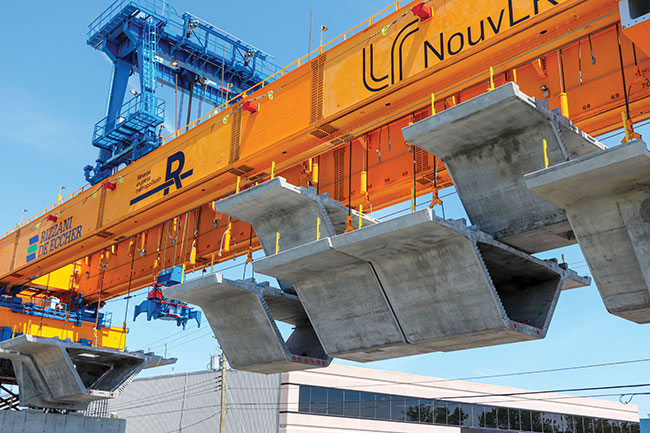
Montreal’s Réseau express métropolitain (REM) project is truly one for the record books. Now under construction, this automated, driverless electric railcar system will serve 26 stations along 67 km of raised, above-ground, and subterranean track. When completed, the REM will extend Greater Montreal’s railcar reach along four new lines to the west, north, and southeast, along with a direct link to the city’s YUL-Aéroport-Montréal-Trudeau. The REM will also connect to the city’s existing 71 km Metro subway system via three station interconnects, and a fourth interconnect to the Réseau de transport métropolitain commuter rail line.
“The REM is the largest public transit project undertaken in Québec in the last fifty years,” says Denis Rivard (P. Eng.), REM project vice-president. “This is also one of the largest automated driverless systems.”
The Nitty-Gritty
The money to build the REM is coming from the Province of Québec government ($1.283 billion), the Canadian government ($1.283 billion), and Hydro-Québec, which is investing $295 million to promote the electrification of transportation. The project’s contractors are SNC-Lavalin, Dragados Canada Inc., Groupe Aecon Québec Ltée, Pomerleau Inc., and EBC Inc. The architects are Lemay, Bisson Fortin, Perkins + Will, and Provencher Roy. The “Provision of rolling stock and systems and operation and maintenance” (RSSOM) contract was won by the Groupe des Partenaires pour la Mobilité des Montréalais (PMM), which is made up of Alstom Transport Canada Inc. and SNC-Lavalin.
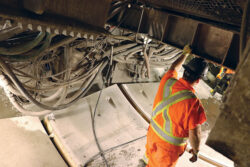
After the surprise detonation of old dynamite left there by the original builders of the tunnel, the REM team took appropriate safety measures.
The 67-km system encompasses 18.2 km of elevated track on the western line and 8 km of tunnels, including rehabilitating a 100-year old train tunnel under Mont-Royal and cutting a new tunnel to the airport. In addition to the 26 stations that are being built out of Quebec stone and wood – with lots of glass in the above-ground structures to take advantage of natural light.
“We have 14 parking lots and 11 big bus stations,” Rivard says. “We have also built five new bridges and three new maintenance centres. These centres are fully automated. The trains park themselves there at night, head to the training washing system in the early morning, and then drive themselves to work.”
Century-Old TNT Tops the List of Tunnel Rehab Challenges
Without a doubt, rehabilitating and widening the 5-km tunnel under Mont-Royal tunnel to Montreal’s Central Station has been the most challenging part of the REM project. Not only was the tunnel falling apart due to decades of road salt leaching in from above in the downtown section, but the original builder’s use of TNT to excavate its length left much to be desired by 21st century standards. It wasn’t just the roughness of the work that posed issues for the REM’s tunnellers – it was the unexploded sticks of dynamite left behind by the original builders in holes in the rock walls of the tunnel.
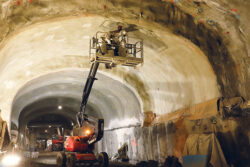
Crews work on the rehabilitating and widening the 5-km tunnel under Mont-Royal tunnel to Montreal’s Central Station.
“In 2020, as the excavation of the platforms of the future Édouard-Montpetit station began, a detonation occurred,” stated the REM.info website. “Work was halted immediately, and thankfully no workers were injured. An investigation that took place following this unanticipated incident identified the cause: explosives from more than 100 years ago left behind in tubes drilled into the bedrock!”
Mindful that further explosive surprises could await them in the tunnel, the REM team took appropriate safety measures.
“We converted all of our drilling equipment to be operated remotely, and kept our workers at a distance of 500 metres,” Rivard says. “We now do the work using cameras, which makes it much more difficult to obtain precision.”
The team also had to convert the tunnel’s deteriorated double arched entrance into a single opening. After months of analysis, they used the “Umbrella Method” to hold up the weight of the tunnel entrance. (The term Umbrella Method refers to a half-circle formed over an arch.)
First, a temporary retaining wall was built to reinforce the structure around the double arch using casings, allowing workers to remove the damaged areas of the entrance walls. Next, the casings were removed and steel arches were installed to support the structure. With this in place, the REM team were able to demolish the central wall and build a new single arch entrance.
To ensure compliance with its design plans, the concrete thickness of the Mont-Royal tunnel interior was mapped and modelled in 3D using the “SOGUN Method.”
First, a LiDAR (Light Detection and Ranging) sensor and thousands of laser beams digitally mapped the tunnel’s surface. Next, the SOGUN’s computer compared the actual surface with that of the design. It then used its laser projection system to shine “different colours onto the tunnel walls to show where work is needed,” stated REM.info. “Along with highlighting small differences on the tunnel walls, numbers indicate how much concrete should be sprayed or removed.”
Three Other Challenges Just as Daunting
The Mont-Royal Tunnel isn’t the only underground effort undertaken by the REM Project team. They are also using an all-in-one tunnel boring machine (TBM) called Alice (named in honour of Canadian geologist and paleontologist Alice Evelyn Wilson) to dig a 3-km tunnel 30 metres below ground between the Technoparc sector and YUL-Aéroport-Montréal-Trudeau station. The TBM is designed to dig the tunnel at its face, remove the debris to the back using a conveyor belt, and install concrete wall casings to hold everything in place.
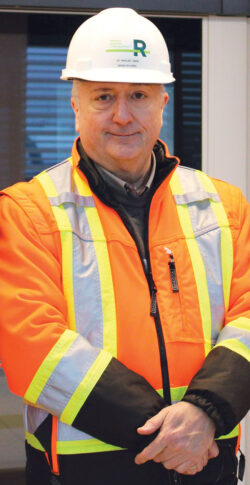
Denis Rivard (P. Eng.), REM project vice-president.
On the way to the airport, the TBM had to cut through soft, soggy marshlands. No problem: The REM Project team simply froze the ground using liquid nitrogen. This turned the marsh mush into rock-solid ice that could be excavated and lined before it melted.
Then there was the 18.2 km of elevated track on the western line ending at Anse-à-l’Orme station. To build 16 km of the route, the REM Project team used a pair of 105-m long ‘launching gantries’, which was a first for Quebec. They rode the existing elevated track to lay succeeding precast concrete spans on prepared columns below. More than 4,000 factory-fabricated spans were laid ranging in length from 30 to 40 metres.
“This system allowed a span to be laid and secured in just 24 hours, rather than the usual two-three weeks,” Rivard says.
Finally, there was the problem of building a two-track rail bridge across the Rivière des Prairies, which bisects Montréal and Laval. Since an existing railway bridge already spans this section of fast water, the REM Project team used that bridge’s piers as foundations for their own — significantly saving time and money without compromising safety. The bridge sections were then ‘incrementally launched’ into place. In this approach, sections are built first on the shore, then pushed out over the water and into place using the section of the bridge that has already been installed. Again, another time-and-money saver.
Pushing Onto Completion
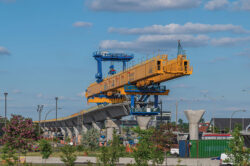
The project includes 18.2 km of elevated track on the western line ending at Anse-à-l’Orme station.
These are just some of the many challenges that the REM Project team has resolved as they push to complete the REM system. “The first trains are scheduled to depart in 2023 between Brossard and Central Station,” stated REM.info. “The segments heading to Anse-à-l’Orme and Deux-Montagne stations are scheduled to begin service at the end of 2024. Finally, the segment to the Montréal Airport is scheduled to open in 2027.”
For Denis Rivard and his team, the scope and success of the REM project is a source of great personal pride.
“The reason why it’s so fun to work on this project is because it’s really outstanding,” he says. “When we are finished, the REM will be the longest driverless system in the world. Right now, Dubai holds that title at 52.1 km (according to the Guinness Book of World Records) but we’ll be taking it from them.”
Print this page